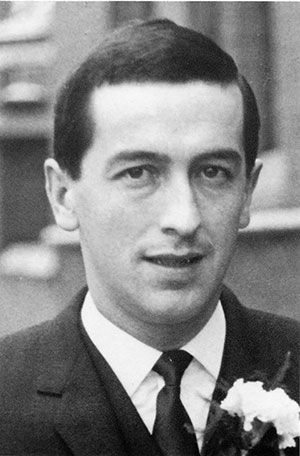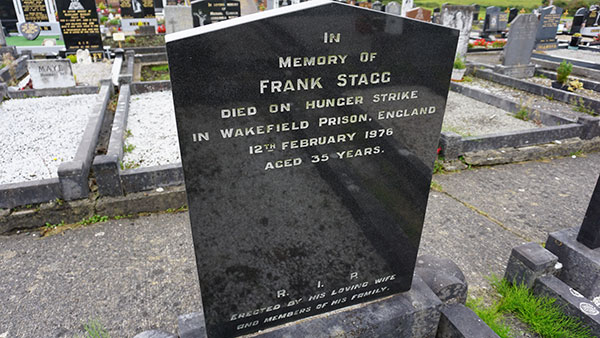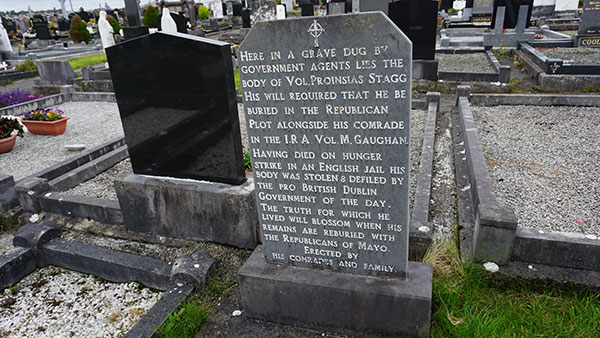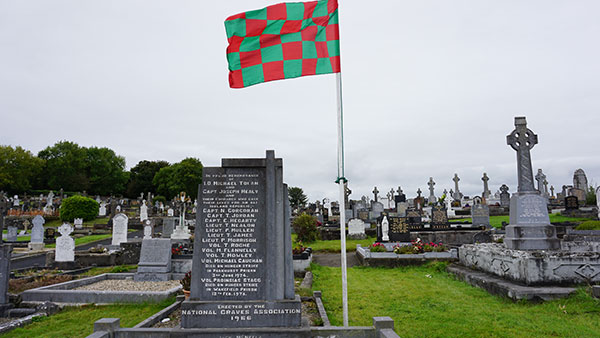Documentary On One: Frank Stagg’s three funerals
Published in Issue 1 (January/February 2018), Reviews, Volume 26RTÉ Radio 1, 5 November 2017
By John Gibney
 The three funerals that are the subject of this compelling instalment of RTÉ Radio 1’s Documentary On One series arose from two very different burials and left behind three very different graves.What they have in common is that theyall relate to the same person. Frank Stagg was from Ballinrobe,Co. Mayo. His father had been in the IRA during the War of Independence, taking the anti-Treaty side in the Civil War, though this did not necessarily have a bearing on the choices his son later made. Frank Stagg was small in stature but of striking appearance, and apparently good company. His father’s musical predilections were a definite influence on him; a haunting snatch of Stagg singing a satirical ballad that he composed about some of the locals where he grew up provides a link to his life in a documentary that focuses on his death. Stagg was the seventh of thirteen childrenand, like so many young men from the west of Ireland,he emigrated, workingas a bus conductor in London. He also, at some point, became involved with the Provisional IRA. His younger brother George (one of the key protagonists in the story, and one of the principal interviewees here) was vaguely aware that his elder brother was involved in republican fund-raising, but in 1973 Frank Stagg was arrested in London and convicted of conspiring to commit arson. In March 1974, in pursuit of political status, he and a number of others went on hunger strike, which was called off after the death of Michael Gaughan, a fellow Mayo man who, like Thomas Ashe in 1917, died after force-feeding by the prison authorities. Stagg embarked on a number of hunger strikes over the next two years. He was particularly aggrieved about the abuse directed at his mother by protestors as she sought to visit him, as well as the petty and vindictive treatment of his family by prison officers. His final hunger strike lasted 62 days; his death on 12 February 1976 was marked by large protests in Belfast.
The three funerals that are the subject of this compelling instalment of RTÉ Radio 1’s Documentary On One series arose from two very different burials and left behind three very different graves.What they have in common is that theyall relate to the same person. Frank Stagg was from Ballinrobe,Co. Mayo. His father had been in the IRA during the War of Independence, taking the anti-Treaty side in the Civil War, though this did not necessarily have a bearing on the choices his son later made. Frank Stagg was small in stature but of striking appearance, and apparently good company. His father’s musical predilections were a definite influence on him; a haunting snatch of Stagg singing a satirical ballad that he composed about some of the locals where he grew up provides a link to his life in a documentary that focuses on his death. Stagg was the seventh of thirteen childrenand, like so many young men from the west of Ireland,he emigrated, workingas a bus conductor in London. He also, at some point, became involved with the Provisional IRA. His younger brother George (one of the key protagonists in the story, and one of the principal interviewees here) was vaguely aware that his elder brother was involved in republican fund-raising, but in 1973 Frank Stagg was arrested in London and convicted of conspiring to commit arson. In March 1974, in pursuit of political status, he and a number of others went on hunger strike, which was called off after the death of Michael Gaughan, a fellow Mayo man who, like Thomas Ashe in 1917, died after force-feeding by the prison authorities. Stagg embarked on a number of hunger strikes over the next two years. He was particularly aggrieved about the abuse directed at his mother by protestors as she sought to visit him, as well as the petty and vindictive treatment of his family by prison officers. His final hunger strike lasted 62 days; his death on 12 February 1976 was marked by large protests in Belfast.

Above: Frank Stagg’s first headstone, hastily erected over the concrete-filled grave.
According to George Stagg, his brother did not want to die. Consequently, he had added a coda to his will in the latter stages of his hunger strike, requesting that he be laid to rest alongside Michael Gaughan in Ballina, with full republican honours. This presented Liam Cosgrave’s coalition government with a dilemma. Former Minister for Justice Patrick Cooney was another key interviewee here; the Cosgrave government (not to mention many people in Ballina) were appalled by the manner in which Gaughan’s funeral had become a political demonstration that traversed the country. Given their feelingthat such demonstrations were deliberately fostered by republicans as a direct challenge to the authority of the state, they had no desire to see this repeated, and Stagg knew this; the change to his will was intended to pressurise the Cosgrave government into intervening with the British. Stagg’s professed final resting place may not have been intended to be his resting place at all.According to Cooney, however, the change of the will was invalid, given the state of Stagg’s health when he made it—an assertion disputed by George Stagg. The family were split on the issue; his brother Emmet, a future Labour TD who declined to take part in the documentary, opposed the idea of a republican funeral.

Above: Frank Stagg’s second headstone, erected by his brother George on an adjacent grave.
Stagg’s body, which British cargo-handlers refused to deal with, was flown back to Ireland on an Aer Lingus cargo plane. As soon as it reached Irish airspace, the plane was diverted from its original destination, Dublin, to Shannon. George Stagg, who had accompanied the body, was arrested on the plane by the Special Branch on an unspecified charge.Against the backdrop of emotional protests in Shannon, with George Stagg assuring the Gardaíthat he would get his brother back, the coffin was carried by helicopter to Ballina, where Frank Stagg was given an extremely heavily guarded first funeral in Mayo before being buried. But Stagg was not buried in the Republican Plot; he was buried in the same graveyard but some distance away, with concrete being used to fill the grave to ensure that the coffin stayed where the government had put it. The second, republican funeral took place the next day, as part of a rally concluding with a tense ceremony in the cemetery surrounded by large numbers of troops that very nearly resulted in major, and potentially violent, disturbances.

Above: Frank Stagg’s third (and final) headstone—in the Republican Plot, Leigue Cemetery, Ballina, Co. Mayo.
The third funeral came on 5 November 1977. Stagg’s grave had been guarded by the police for six months to avoid the prospect of his being reinterred elsewhere. Amidst all of the security, however, the authorities had overlooked one major detail: they had never actually purchased Stagg’s grave, and therefore did not own it. George Stagg bought the grave and the adjoining plot and, on the night of 4–5 November 1977, dug down and around the concrete that covered his brother’s grave, and reinterred him in the Republican Plot. As he had promised, George Stagg had gothis brother back.
The strength of this documentary was that it told a story that was personal as well as political, evoking the pain felt by a family as much as the almost surreal political climate of the day, especially as experienced by those on all sides who were there on the ground at the time. The Cosgrave government has often been accused of heavy-handed and authoritarian policies, charges that are countered by the assurance that in the climate of potential violence at the timea firm approachwas necessary; Cooney (or ‘Concrete Cooney’, as he was dubbed in some quarters), to be fair, had reservations about the government’s show of force, and viewed the actions taken as a necessary evil. Frank Stagg’s story is naturally overshadowed by the hunger-strikers of 1981, but this vivid and powerful documentary, produced by Liam McNally and Ronan Kelly and broadcast on the 40th anniversary of his reinterment, brought this extraordinary episode back to the light. This was an excellent instalment in a distinguished series; listen back to it here:http://www.rte.ie/radio1/doconone/.
John Gibney is Department of Foreign Affairs and Trade 100 Project co-ordinator with the Royal Irish Academy’s Documents on Irish Foreign Policy project.
















